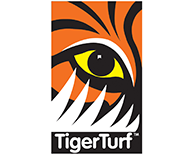
In the interest of water conservation, sports clubs should consider the installation of a 3G pitch to replace their natural grass pitch.
Many sports clubs have argued this is not practical due to the disadvantages associated with artificial turf. The information below shows how artificial turf technology has developed over the years so even professional sports clubs can use a water saving 3G pitch with confidence of meeting essential player safety and performance requirements.
Natural Grass
A sports field with natural grass requires a significant amount of water to maintain the surface quality. This can be seen in the above photo which shows a sprinkler system watering the football pitch prior to a game. An adequate supply of water helps the grass to stay in optimum condition.
This is especially important on a sports field (as opposed to a garden lawn) because studs from players’ boots churn up the turf and create muddy patches. Regular watering and feeding is required for the grass to recover. Sometimes reseeding or resurfacing is also required to replace damaged areas of the pitch.
In the summer months there is a likelihood of brown grass or dead grass without sufficient water. Intense heat from the sun causes the ground to dry up faster in the summer so the grass roots cannot draw water from the soil. In colder months, water is retained in the ground for longer so watering can be performed less frequently.
Artificial Turf

Artificial turf was originally invented in 1965 and solved many problems associated with natural grass. Water was no longer a requirement thus making sport possible in arid climates such as Africa. Even in wet climates, artificial turf can help towards water conservation during droughts.
Unfortunately, the early artificial turf sports fields were known for unrealistic ball responsiveness and a cause of player injury due to the hard surface. New product developments in the 1980s led to a second generation of artificial turf that was cheaper to produce due to the introduction of a less dense fibre and the gaps filled with sand. Although this was a cost effective solution, it had similar problems associated with the original hard surface. Therefore, despite the water conservation benefits of artificial turf, it would be unreasonable to expect sports clubs to adopt the surface. Further development was needed.
3G Pitch

A 3G Pitch (third generation pitch) provides a sports surface that not only conserves water but also meets the needs of the players.
3G artificial turf provides a safe and realistic alternative to natural grassand was invented in the mid 1990s. The success of a 3G Pitch is due to a number of improvements. Firstly, the fibres are made of a softer material known as polyethylene. Secondly, recycled rubber is now used as an infill which is much softer than the original sand. Finally, the artificial turf fibres protrude at least 20mm above the layer of infill to give a surface that responds just like natural grass.
Due to this significant advancement in manufacturing, sports clubs around the world are once again turning their attention to artificial turf surfaces. A 3G pitch can and no doubt will play an important part in the future of sport and water conservation.



